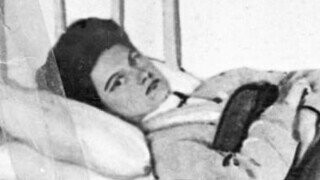The Surprisingly Complicated Case of Typhoid Mary

Typhoid Mary gets a bad rap, considering she, you know, killed people, if only inadvertently. She’s often viewed as the Victorian version of a frothing anti-masker, flagrantly disregarding the health of others for her own selfish desires, but the truth is that she was an Irish woman in a time and place when that was a very bad thing to be, living in deep poverty, surrounded by people who both wanted to lock her up and couldn’t give her a good reason why. It would take an exceptional boot-licker not to rebel in that situation.
Mary Mallon

Mary Mallon, as she was legally known, was born on September 23, 1869 in Ireland. Like many of her countrymen in the same period, she eventually immigrated to New York City, but she was only 14 or 15 and completely alone, headed to a country where people regarded the Irish as little more than annoyingly hungry Roombas.
Miss Mallon

Mallon worked her way up to the position of cook, which was considered the top of the pecking order of domestic servants, offering the best pay, the most respect, and even the title of “Miss” rather than “You, there.” The nature of her work was transient, though, and she moved through several different families, so she was often long gone by the time they started developing symptoms of typhoid fever.
She Didn’t Know
It’s likely Mallon was born a carrier of the bacteria that causes typhoid fever, since her mother was infected during pregnancy, and she never showed symptoms as far back as she could remember. In fact, she was astonishingly healthy for someone in her circumstances, and nobody back then knew what an “asymptomatic carrier” was.
Caught by Capitalism

In fact, the only reason Mallon was identified was because she’d traveled with a wealthy family to a summer house they’d rented for the season in 1906, and the ensuing outbreak of typhoid fever (which was for poors) in the area caused a minor scandal and worried the house’s landlord that something about it was about to make it unrentable. He hired sanitation engineer George Soper, who found no cause for concern in the landlord’s cash cow but did realize the same cook had worked for all the rich families who fell ill.
Ambushing Mary

You may have heard that Mallon attacked medical professionals who tried to treat her with a fork, which is sort of true, but also sort of understandable. Soper tracked her down to a Park Avenue brownstone where she was working and wasted no time demanding samples from her despite her insistence that she felt fine, so yes, she “seized a carving fork and advanced in direction.” Wouldn’t you if some weird dude showed up where you work and asked for your poop?
Dragged and Sat On

Seeing that he was getting nowhere, Soper called in a doctor who was likewise fended off but later wrote that she completely understood why Mallon “could not trust us.” In the end, it took five cops to drag Mallon (so scared she was found hiding in a closet) into an ambulance, where the doctor didn’t let her sympathy stop her from sitting on her to keep her there, and force her to provide urine and feces samples. Let’s not think about what that must have entailed.
Forced Into Quarantine
Mallon spent the next three years essentially in solitary confinement in a quarantine facility in the Bronx, where doctors attempted all kinds of weird and unsuccessful treatments, offered to remove her gallbladder without explaining it was likely the bacteria’s home (she obviously declined), and failed to explain to her how she could be sick when she felt fine. In other words, she was held prisoner by people trying to steal her organs. That’s a straight-up horror movie.
She Had Reason to Doubt

Mallon didn’t consistently test positive for typhoid; in fact, when she sneaked samples out to be tested by an independent laboratory, they came back negative, confirming her suspicions, as far as she was concerned, that she’d been kidnapped and imprisoned without cause. It’s not like those quacks who kept giving her brewer’s yeast and trying to take out her organs seemed to know what was going on, either. She wrote to a reporter that she felt she’d been “banished like a leper” even though she “never had typhoid in life.”
The Smear Campaign

She probably wrote to a reporter specifically because if you think the general public didn’t like the Irish in the early 20th century, you can imagine what they did to an Irish woman who’d sickened dozens and killed at least one, by that point, with her grossness. She’d “become the butt of jokes cartoons” in the media, which had dubbed her “Typhoid Mary,” especially in the sensationalist newspapers of William Randolph Hearst, who is believed to have paid her legal fees either out of guilt or because the continued story was great for selling papers.
Oh, Yeah, She Sued
After more than a year of confinement, Mallon sued the New York City Department of Health for violating her civil rights. Her lawyer argued that she’d been imprisoned without due process, and besides, her independent lab results were negative. She lost her case, but the tide of public opinion began to turn for Mallon, especially since…
She Was Far From the Only One

During Mallon’s legal battle, Science magazine published an article arguing that, because they’d since learned that about 4% of people who recovered from typhoid became asymptomatic carriers, “There are at the present moment probably 560 such persons in the state of New York” and “We cannot keep in detention all these people, why single out and imprison one?” Today, historians do believe she was unfairly targeted because she was “female, Irish, uncooperative, and without a family.”
Why She Disobeyed
Mallon is vilified mostly because after she was released in 1910 under the condition that she never work as a cook again, she totally crossed her fingers behind her back, adopted a series of fake names, and did just that. But she’d only been released back to crushing poverty, couldn’t find a job that paid as well, and remained unconvinced, fairly reasonably, that she was a danger to anyone. That, of course, didn’t work out so great: She spread typhoid to 25 more people, two of whom died.
Final Quarantine

After the outbreaks led the authorities back to Mallon and her broken promise, she was forced back into quarantine for the last 23 years of her life. Again, none of the 400 other people identified as asymptomatic carriers by New York officials, one of whom infected way more people and even caused more deaths, were sentenced to such a fate, but Mallon had to be punished. She knew the legal system wouldn’t have her back, so she had no choice but to hunker down and get cozy.
Mallon’s Death
As if she hadn’t already cut a pitiful enough figure, Mallon was found on Christmas morning 1932, after who knows how long, by a delivery man on the floor of her quarantine cottage, having suffered a stroke. She spent the next six years bedridden and paralyzed before she died alone.
Autopsy?

After Mallon’s death, it was reported that her autopsy showed typhoid bacteria shedding from her gallbladder, seemingly justifying her life sentence to solitary confinement, but even Soper wrote in his memoirs that no autopsy ever occurred, and no evidence of one has ever been located. Even in death, the media couldn’t keep the poor woman’s name out of their mouth.
Top image: The New York American/Wikimedia Commons